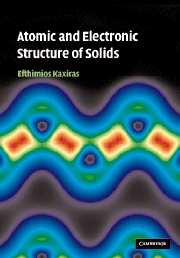Book contents
- Frontmatter
- Contents
- Preface
- Acknowledgments
- I Crystalline solids
- II Defects, non-crystalline solids and finite structures
- III Appendices
- Appendix A Elements of classical electrodynamics
- Appendix B Elements of quantum mechanics
- Appendix C Elements of thermodynamics
- Appendix D Elements of statistical mechanics
- Appendix E Elements of elasticity theory
- Appendix F The Madelung energy
- Appendix G Mathematical tools
- Appendix H Nobel prize citations
- Appendix I Units and symbols
- References
- Index
Appendix B - Elements of quantum mechanics
Published online by Cambridge University Press: 06 July 2010
- Frontmatter
- Contents
- Preface
- Acknowledgments
- I Crystalline solids
- II Defects, non-crystalline solids and finite structures
- III Appendices
- Appendix A Elements of classical electrodynamics
- Appendix B Elements of quantum mechanics
- Appendix C Elements of thermodynamics
- Appendix D Elements of statistical mechanics
- Appendix E Elements of elasticity theory
- Appendix F The Madelung energy
- Appendix G Mathematical tools
- Appendix H Nobel prize citations
- Appendix I Units and symbols
- References
- Index
Summary
Quantum mechanics is the theory that captures the particle-wave duality of matter.
Quantum mechanics applies in the microscopic realm, that is, at length scales and at time scales relevant to subatomic particles like electrons and nuclei. It is the most successful physical theory: it has been verified by every experiment performed to check its validity. It is also the most counter-intuitive physical theory, since its premises are at variance with our everyday experience, which is based on macroscopic observations that obey the laws of classical physics. When the properties of physical objects (such as solids, clusters and molecules) are studied at a resolution at which the atomic degrees of freedom are explicitly involved, the use of quantum mechanics becomes necessary.
In this Appendix we attempt to give the basic concepts of quantum mechanics relevant to the study of solids, clusters and molecules, in a reasonably self-contained form but avoiding detailed discussions. We refer the reader to standard texts of quantum mechanics for more extensive discussion and proper justification of the statements that we present here, a couple of which are mentioned in the Further reading section.
The Schrödinger equation
There are different ways to formulate the theory of quantum mechanics. In the following we will discuss the Schrödinger wave mechanics picture.
- Type
- Chapter
- Information
- Atomic and Electronic Structure of Solids , pp. 530 - 563Publisher: Cambridge University PressPrint publication year: 2003



